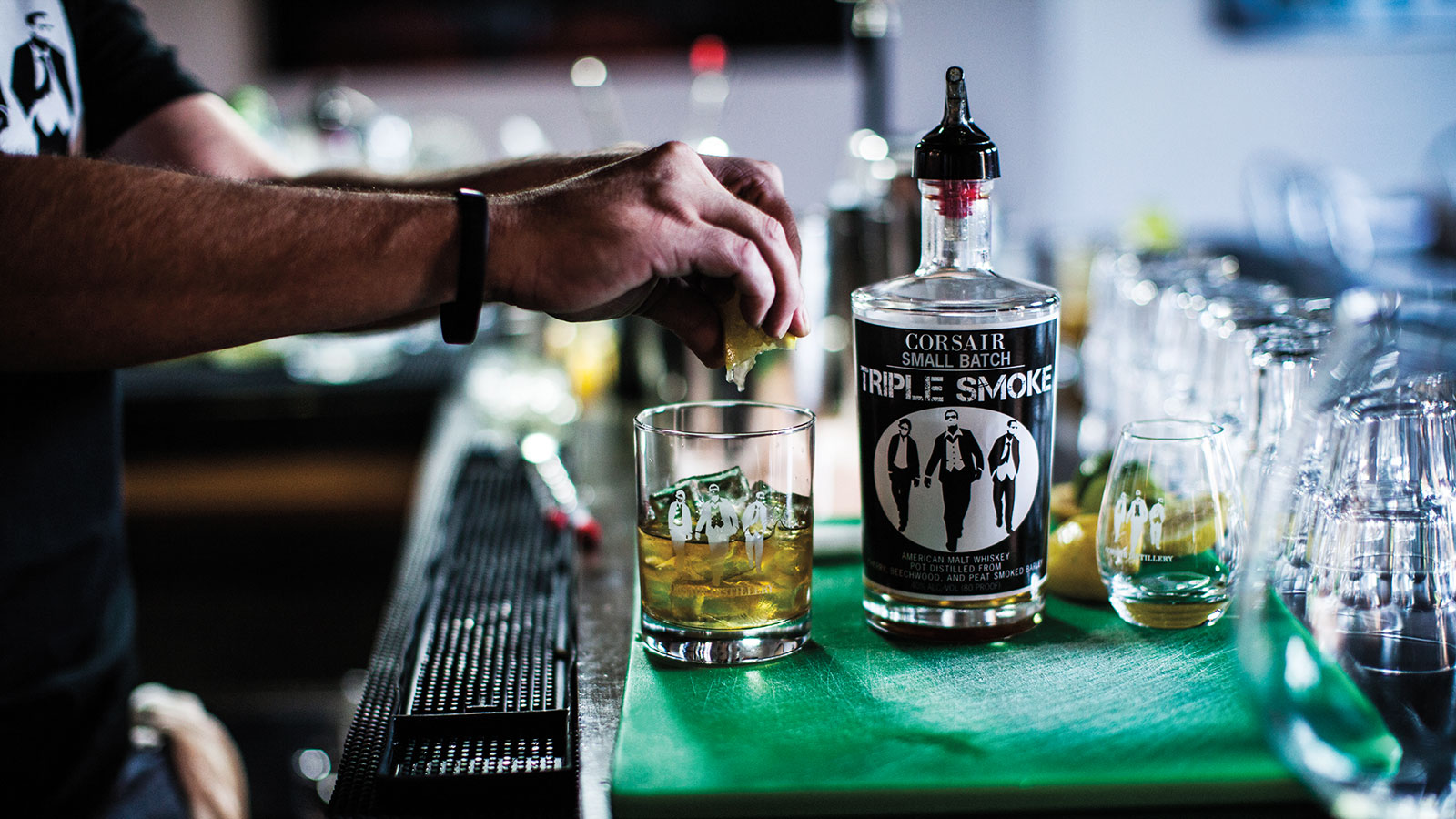
Scottish peat isn’t the only smoke game in town and American producers are leading the charge by using all types of smoke to create new, unique whiskeys.
There’s no better place to start than with the guy who wrote the book on it—literally. Corsair distillery’s Darek Bell wrote Fire Water: Experimental Smoked Malts and Whiskeys. He’s worked with a massive assortment of woods and other fuel sources, carefully controlling variables such as time, humidity, terroir of the fuel, and how well different grains absorb various types of smoke.
“We quickly became frustrated that there were so few options of types of smoked malts to buy, so we began malting and smoking our own grains,” says Bell. Corsair offers a changing collection of smoked whiskeys among their seasonal and experimental releases, but their penchant for smoke is most prominent in their popular Triple Smoke. The mashbill incorporates three separately smoked malts, with cherrywood, beechwood, and yes, peat. “We find blending different smoke types results in more flavor complexity,” he says.
Cherrywood is also being used by Copper Fox distillery. Owner Rick Wasmund interned at Bowmore under the recently retired Jim McEwan, and brought back a similar malting and kiln-smoking setup to what he saw there. For Wasmund’s single malt, he uses a tandem of 60 percent applewood and 40 percent cherrywood to smoke his barley. That malt is also a component in the mashbill of his rye whiskey. Copper Fox further recycles that wood for a unique aging system. “We rotate used oak and applewood chips through our barrels as the whiskey ages,” explains brand ambassador Abby Hopper.
Mesquite wood smoke is a distinctly southwestern American flavor, and at least three producers there are using it for whiskey. Santa Fe Spirits produces Colkegan single malt, incorporating a mixture of 30 percent mesquite-smoked and 70 percent unsmoked barley. “It is a very different kind of smoke flavor to peat,” says Santa Fe’s Adam Vincent. “If you were to smell the grain out of the bag, it smells distinctly of barbecue and in the glass comes across sweeter and perhaps meatier than peat.”
Hamilton Distillers handles their own malting and smoking; however, in place of a traditional floor malting environment, they’re using new technology. “It’s a prototype system, it doesn’t really exist anywhere else quite like this,” says owner Stephen Paul. It consists of two tanks: a steeping tank and a dual-purpose germination and kilning tank. “It allows us to have much more control…. We know the temperature of the air coming in and out, humidity going in and out, all kinds of sensors all over the place.” Hamilton produces Del Bac Dorado, a mesquite-smoked single malt, and Del Bac Clear, its unaged version, along with an unsmoked single malt, Del Bac Classic.
Ranger Creek uses mesquite to cold-smoke malted barley for their Rimfire single malt via a system they constructed. “We bought a shipping container and welded a firebox onto the back and a chimney onto the front,” explains co-founder Mark McDavid. Then they lined it with screens and shelves, and voila, a huge smoking compartment was born. Balcones Distilling uses a different local fuel source. Their Brimstone corn whiskey is smoked with Texas scrub oak. Rock Town distillery offers Hickory Smoked whiskey, a wheat whiskey made from 91 percent wheat and 9 percent malted barley. “I decided to use a hickory smoke because in Arkansas, when we make barbecue, we typically smoke it with hickory,” says founder Phil Brandon. He also created his own cold-smoking system, customizing a large wooden cabinet.
Now for the first time American peat is also entering the smoked scene. “This year we’re adding Washington State peated malt to the mix, which we’ve been working on basically since we started,” says Westland distillery co-founder and master distiller Matt Hofmann. First though they needed to find a maltster who would make it, eventually connecting with fellow Washington startup Skagit Valley Malting after previously working with prominent UK supplier Baird’s. “We knew that one day we wanted to use Washington State peated malt because we have plenty of peat here. We’re putting a pretty big bet on peated,” he says.
A smoky American whiskey world awaits.






